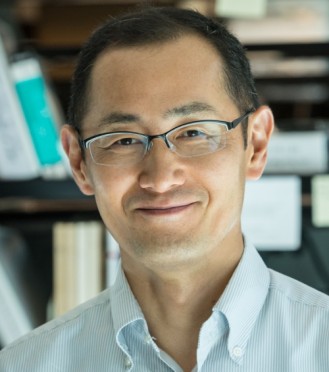Gladstone NOW: The Campaign Join Us on the Journey✕
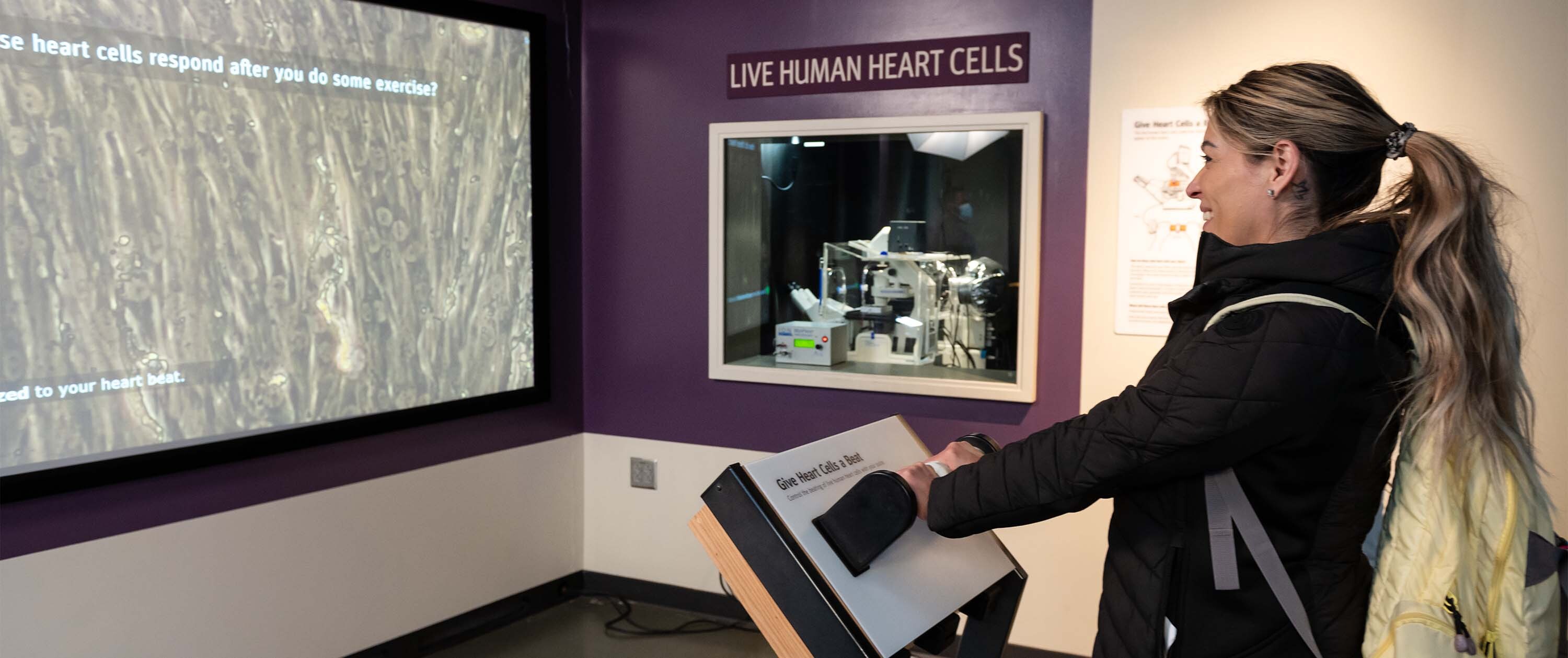
At San Francisco’s Exploratorium, visitors sync their heartbeat with living heart cells; the first-of-its-kind exhibit was created through the museum’s long-running partnership with scientists at Gladstone Institutes.
One of the country’s best-known science museums, San Francisco’s Exploratorium, is located less than three miles north of Gladstone Institutes—a proximity that has resulted in creative, high-science collaborations like the permanent exhibit featured in the latest issue of Stem Cell Reports.
Among the museum's most popular exhibits, “Give Heart Cells a Beat” opens a rare window into the microscopic world of the beating human heart, using technology and materials made possible through Gladstone’s science and expertise. With the exhibit, the team created the first interactive museum experience that allows the public to interact directly with living cardiomyocytes, or heart muscle cells.
It’s like having a lens into yourself because these same types of cells are within us
“It’s like having a lens into yourself because these same types of cells are within us—it’s an incredible experience for our visitors,” says Kristina Yu, PhD, senior director of science R&D for the Exploratorium.
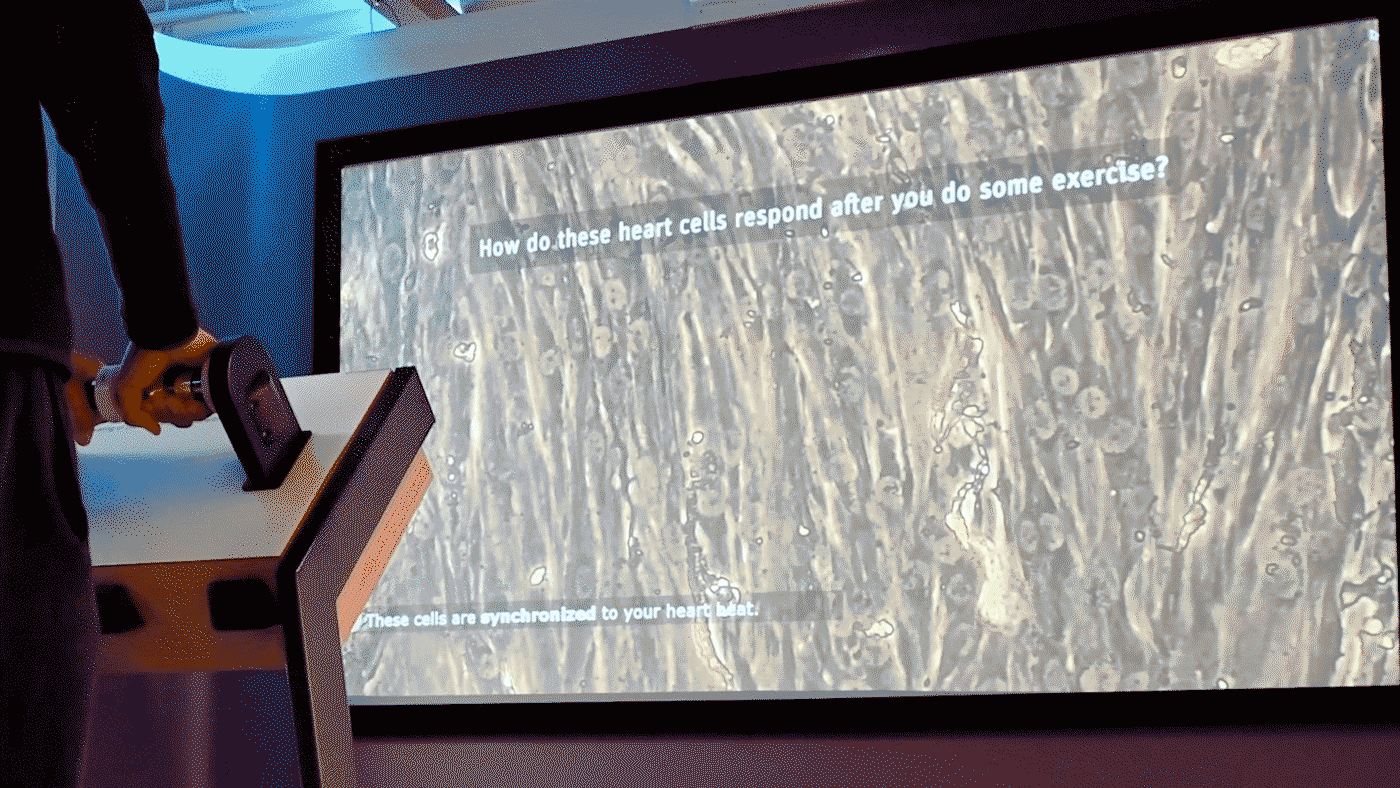
At the “Give Heart Cells a Beat” exhibit, a visitor's heart rate is sent as an electrical signal from handlebar sensors to a lab dish of living heart cells, located behind a window a few feet away. Soon, the cells begin pacing in beat with the visitor’s heart.
As visitors approach the exhibit, a projected video displays beating heart cells—as many as 200,000—on an oversized monitor. Visitors hold onto handlebar sensors in front of the screen and feel their pulse through their hands. Then, within seconds, they watch as the heart cells on the screen begin beating in sync with their own heart.
“The juxtaposition of the very small cells in dish with a large image on screen is quite powerful,” Yu says.
Bruce Conklin, MD, a senior investigator at Gladstone, has been collaborating with Yu and others at the Exploratorium for more than 15 years, well before the exhibit opened in 2019. In fact, the idea for the heart exhibit came from a scientist in Conklin’s lab—and it began with a seemingly simple question: Would it be possible to take beating heart cells from the lab and find a way to synchronize them with the hearts of visitors?
“We’re always searching for a natural phenomenon that enables a visitor to have an immediate experience with something alive,” Yu says. “That’s incredibly difficult to do at scale, which is why this idea just cried out to be done—even though we knew it would be incredibly difficult.”
Watch as the Exploratorium’s Dana Carrison-Stone explains how the interactive exhibit is able to sync up visitors’ heartbeats with living heart cells housed at the museum.
Yu and Conklin, along with their respective teams, share their experience launching and running the heart beat exhibit in a new study that appears in Stem Cell Reports. To their knowledge, it’s the first interactive museum exhibit to use live human heart cells—which, in this case, are derived from adult skin cells and then developed into heart cells at Gladstone using stem cell technology.
“By sharing our experience in such detail, we hope the exhibit will serve as a model that inspires future relationships between academia and public science venues all over the world,” Conklin says. “We’ve been able to create a very powerful and relatable experience that sparks discussion about the heart and health, as well as stem cell science.”
The Heart of the Exhibit
Through interviews with museum visitors who interacted with the exhibit, the Exploratorium found that 90% reported thinking more about their own hearts, 30% remarked on the technology behind the exhibit, and 20% specifically mentioned stem cells. In addition, visitors engaged longer with the heart-cell exhibit than they did with the 37 other exhibits, the journal article says.
Importantly, visitors also get to learn how the exhibit works: They’re taught that their heart rate is sent as an electrical signal from the handlebar sensors to a lab dish that holds living heart cells, located behind a window a few feet away. When the cells receive the signal, they begin pacing in beat with the visitor’s heart. Written cues on the monitor encourage visitors to increase or lower their heart rate to see how the cells react, or to invite a friend to use the handlebars to compare heart rates.
“It’s always fun to watch visitors’ reactions,” Yu says. “We see them doing jumping jacks and running in place to elevate their heart rate, which quickly translates within the video image. The best thing is when they gesture to their friends to come over and try the experience themselves.”
She says it requires much less explanation than other types of biological phenomena because our heart beat is something we experience our whole life: “Although you’ll never get a chance to look at your own living heart cells, you feel them every day. This exhibit allows visitors to have an electrical dialog with these cells.”
Heart cells are unique in their ability to interact with visitors
Despite numerous challenges, not the least of which is keeping heart cells alive in a dish for many months at a time, it turns out that heart cells are unique in their ability to interact with visitors.
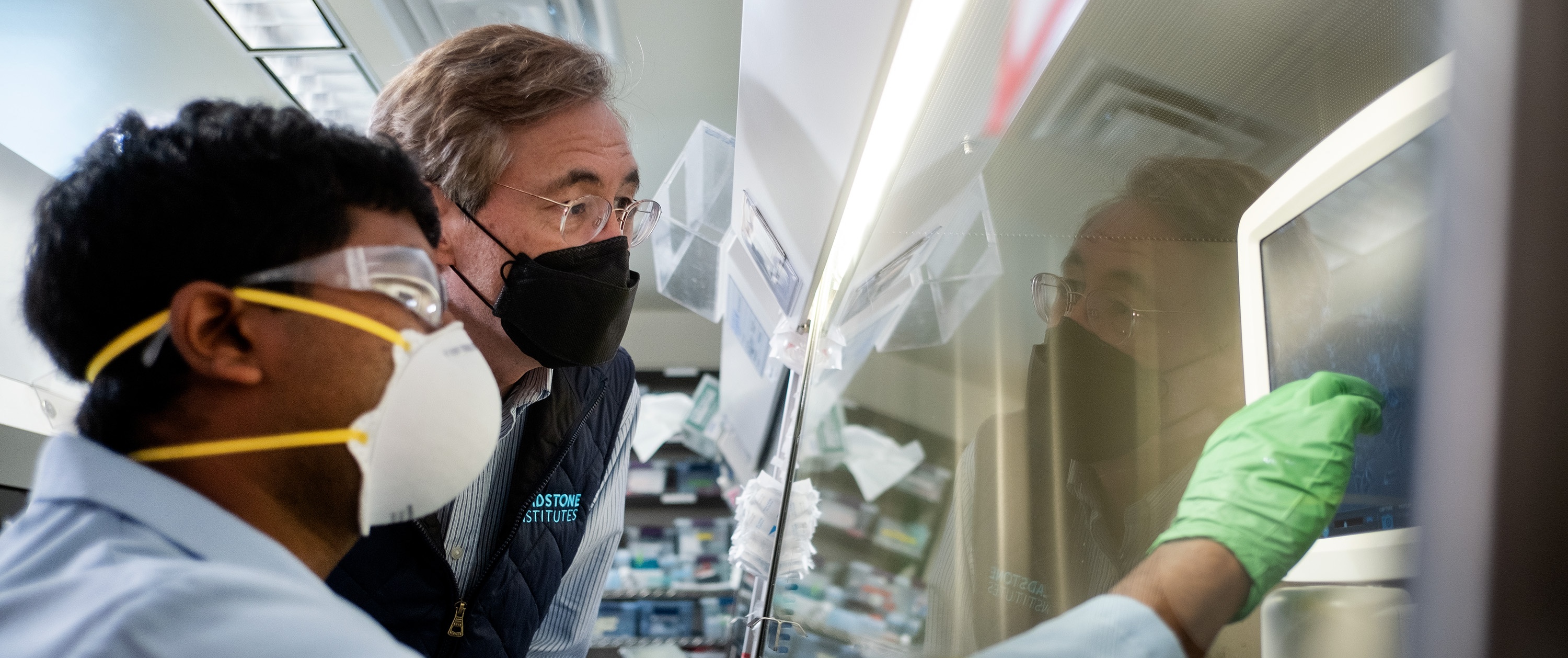
Bruce Conklin (right) a senior investigator at Gladstone, has been collaborating with the Exploratorium for more than 15 years. In fact, the idea for the heart exhibit came from a scientist in Conklin’s lab.
“Heart cells have a dynamic behavior in real time, which is beating, and they can respond to external signals,” explains Juan Perez-Bermejo, PhD, a former postdoctoral fellow in Conklin’s lab who played a key role in developing the exhibit. He is also first author of the new study. “No other cells can do this in a way that could be the center of an exhibit.”
Stem Cell Science in Action
Indeed, the underlying science that makes the exhibit possible is nothing short of prizeworthy.
Gladstone Senior Investigator Shinya Yamanaka, MD, PhD, pioneered the technology that enables scientists to reprogram adult cells into an embryonic state. Known as induced pluripotent stem cells—or iPSCs—these cells have the ability to develop into any kind of cell in the body. They’re the basis for the fast-growing field of regenerative medicine, and their tremendous potential for transforming medicine earned Yamanaka the 2012 Nobel Prize in Physiology or Medicine.
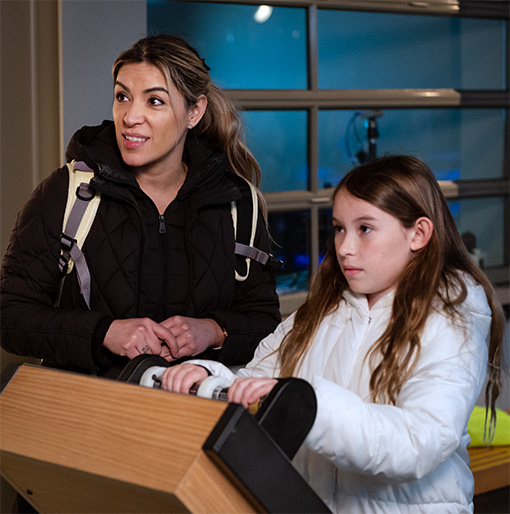
For visitors of all ages, engagement levels are higher than average at the “Give Heart Cells a Beat” exhibit, a sign of public interest in the heart and stem cell technology.
The human heart cells in the Exploratorium exhibit were once skin cells. Using Yamanaka’s technology, Gladstone scientists reprogrammed them in the lab to become iPSCs, then prompted them to grow into a different type of cell: cardiomyocytes, or heart muscle cells.
Conklin’s team often uses tissue created from the skin cells of patients who carry disease mutations and study the tissues in the lab to better understand what causes cardiovascular disease and how to treat it. The cells in the exhibit are left over from experiments, and because they were developed for specific research purposes, cannot be used for other studies.
“Our goal was to take a phenomenon like beating heart cells and craft an amazing, wow-inducing activity that allows someone with no biological knowledge to make a connection with the biological world,” Yu says.
It’s not just the visitors who relish the wonder of interacting with living heart cells. Conklin admits to experiencing a thrill each time he peers into the dish.
“At first, when you look at them, you don’t see anything going on because your eye doesn’t know where to look,” he explains. “But once you see one area of movement, you spot others, and you realize these heart cells are beating and you get a chill up your spine. It’s really a magical moment that conveys the excitement of scientific discovery.”
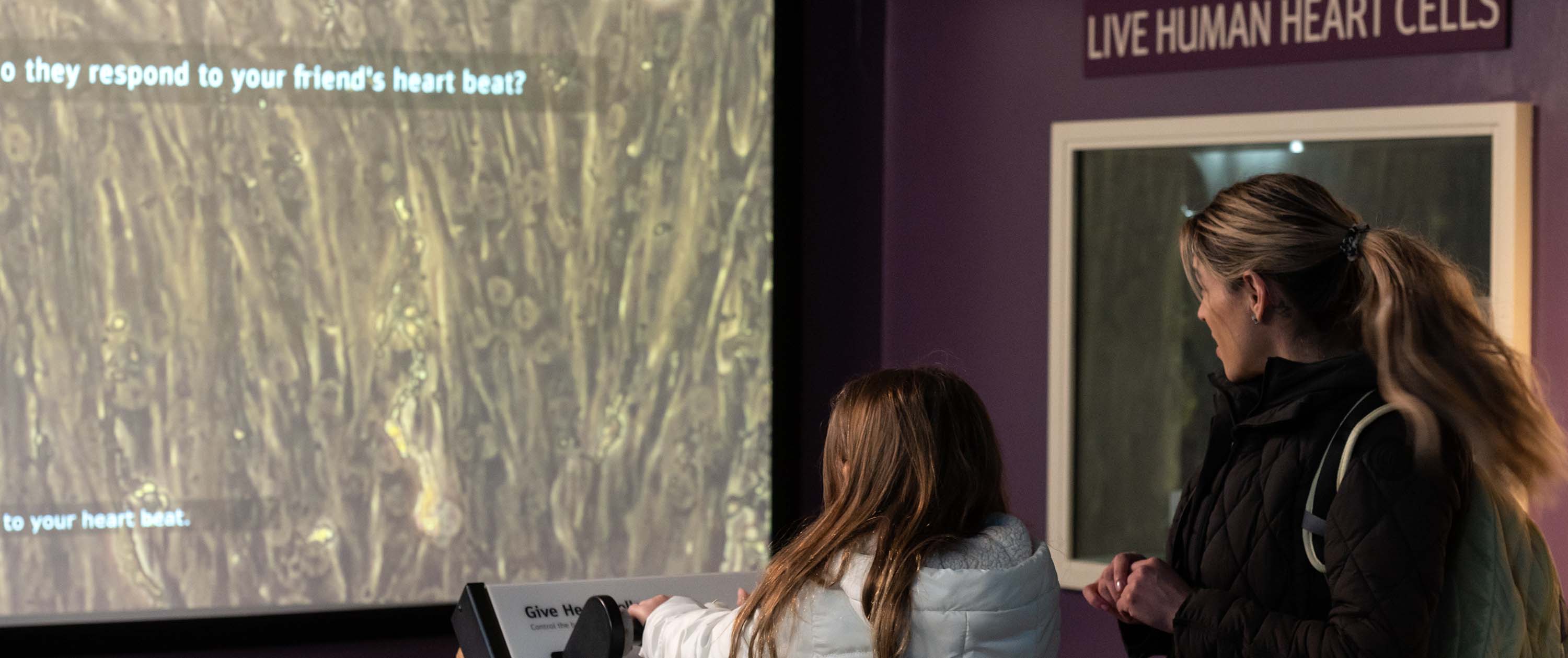
Gladstone scientists hope the interactive exhibit serves as an example of how stem cell technology can be used in informal science education, and that it inspires future relationships between academia and public science venues.
Possible Through Partnership
Human cell lines are extremely susceptible to contamination, so caring for them requires very specific skills and expertise. Conklin credits the highly skilled staff at the Exploratorium for making the exhibit a success.
“Not every museum could do this,” he says. “There’s a lot of work that goes into maintaining these cells, keeping them healthy and alive, but the Exploratorium actually has trained PhDs in molecular biology on staff. They’ve been tremendous partners.”
In this video, learn how Gladstone’s long-running scientific collaboration with the Exploratorium has brought to life first-of-their-kind exhibits, such as the “Give Heart Cells a Beat” exhibit featured in the journal Stem Cell Reports.
The person responsible for looking after the cells in the exhibit is Dana Carrison-Stone, biologist and laboratory manager at the Exploratorium. She says that after the heart cells beat for a few months, they need to be replaced with new cells. Luckily, Gladstone is nearby.
“The easiest way is to bike over,” says Carrison-Stone, an author of the study. “I pack a Styrofoam container with dry ice, put it in my backpack, hop on my bike and ride over to Gladstone, where I meet one of the scientists. They take me to the liquid nitrogen tanks where the cells are stored; I pick up a replacement batch, put it in my backpack, and ride back to the Exploratorium to begin the thaw process.”
The close collaboration between Gladstone and the museum makes the exhibit possible, she adds: “We wouldn’t be able to have this exhibit without Gladstone. The scientists are always there if I have questions or need help troubleshooting or problem solving.”
Gladstone scientists also help by sharing creative concepts for exhibits and helping the Exploratorium showcase leading science that will engage the general public.
“Big ideas for a museum exhibit often come from places like Gladstone,” Yu says. “The scientists suggest what is on the cutting edge of scientific frontiers and we think about how that can be translated into a visitor experience. Then we work together to see how to make it happen. Gladstone provides resources, expertise, and deep knowledge that we really lean on, so we can create a really amazing experience for the public.”
Watch More Videos about the Exhibit
For Media
Kelly Quigley
Director, Science Communications and Media Relations
415.734.2690
Email
About the Study
The paper, “Give heart cells a beat: an interactive museum exhibit that synchronizes stem cell-derived cardiomyocytes to visitors’ heartbeat,” was published in the journal Stem Cell Reports on February 8, 2024. In addition to Bruce Conklin, Kristina Yu, Juan Perez-Bermejo, and Dana Carrison-Stone, authors include: Samuel Reisman, Joyce Ma, and Chris Cerrito of the Exploratorium, and Alexandre Ribeiro of Gladstone.
About Gladstone Institutes
Gladstone Institutes is an independent, nonprofit life science research organization that uses visionary science and technology to overcome disease. Established in 1979, it is located in the epicenter of biomedical and technological innovation, in the Mission Bay neighborhood of San Francisco. Gladstone has created a research model that disrupts how science is done, funds big ideas, and attracts the brightest minds.
About the Exploratorium
The Exploratorium is a portal to the astonishing scientific phenomena that animate our world and shape our actions. It creates extraordinary learning experiences that ignite curiosity, upend perceptions, and inspire brave leaps forward. Since 1969, the Exploratorium has been home to a renowned collection of exhibits that draw together science, art, and human perception, changing the way science is taught. Its award-winning programs provide a forum for the public to engage with artists, scientists, policymakers, educators, and tinkerers to explore the world around them. The Exploratorium celebrates diversity of thought, inspired investigation, and collaboration across all boundaries.
Featured Experts
Genomic Maps Untangle the Complex Roots of Disease
Genomic Maps Untangle the Complex Roots of Disease
Findings of the new study in Nature could streamline scientific discovery and accelerate drug development.
News Release Research (Publication) Marson Lab GenomicsSix Gladstone Scientists Named Among World’s Most Highly Cited Researchers
Six Gladstone Scientists Named Among World’s Most Highly Cited Researchers
The featured scientists include global leaders in gene editing, data science, and immunology.
Awards News Release Corces Lab Doudna Lab Marson Lab Pollard Lab Ye LabThe Genome Editing Playbook Is Different in Neurons
The Genome Editing Playbook Is Different in Neurons
The striking findings of a new study could influence how gene therapies are designed for many genetic diseases.
News Release Research (Publication) Neurological Disease Conklin Lab Doudna Lab CRISPR/Gene Editing


